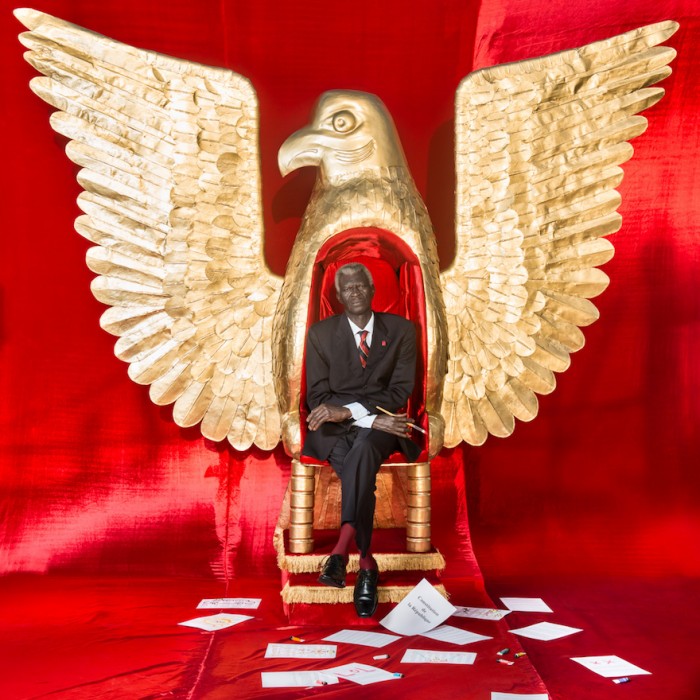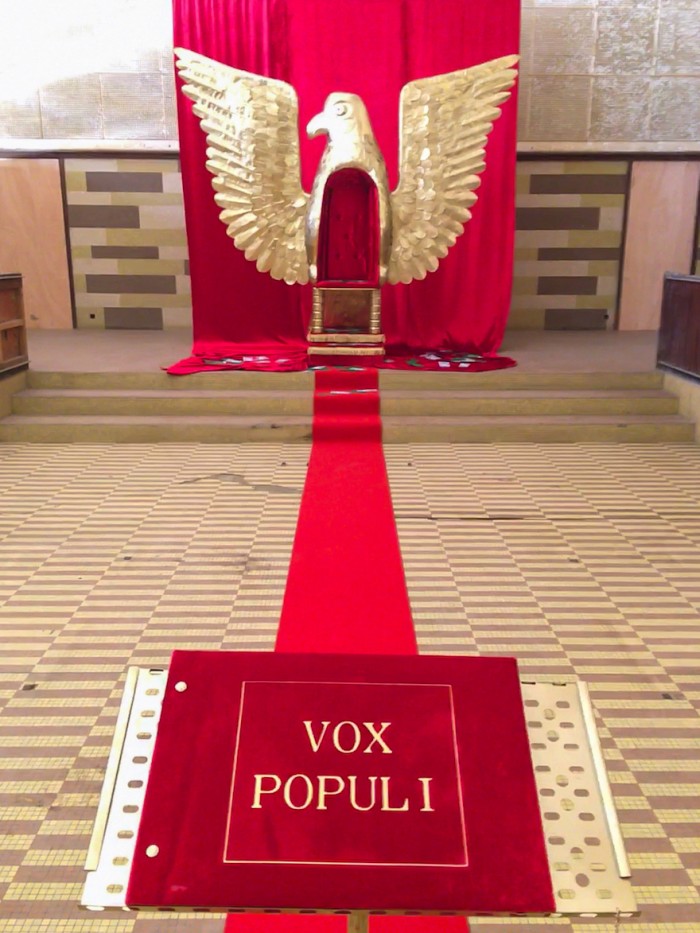Senegal-based Beninese photographer Fabrice Monteiro creates striking image series that reflect the baser sides of humanity. From terrifying visions of a world choked by garbage, to highly stylised and surreal portraits that address social issues such as slavery and genocide, Monteiro's work is not shy of challenging topics. His unique combination of documentary photography and fashion photography has led to the creation of parallel, dystopian worlds, but reflect realities that he believes we are already experiencing. In his most recent series, (P)residant, Monteiro presents African presidential characters who have taken up residence in the seat of power. We talk to Monteiro about his latest work.
What does the series mean to you?
“You must love your leader
you must teach the people to love their leader
this is the only most important thing” – General Idi Amin Dada
This series is a statement of more than 60 years of independence in Africa through the prism of absolute power.
The series is an allegory to all the perversions going on the continent since independence such as nepotism, clientelism, corruption, misappropriation of funds, the fact that one can decide to change the constitution for his benefit and get away with it but also the work is pointing at the ex-coloniser that is still playing his part in many countries across the continent.
There are a lot of small elements, symbols and objects in the pictures that address those issues. I call them “les presidents residants” because they never want to leave power once in the seat.
What inspired you to create (P)residant now?
Lately, there has been a few African presidents who have tried, with more or less success, to maintain themselves in power by simply changing the constitution sometimes even with the support of their ex-coloniser. How come that kind of behavior still exist in our days? And why is it still possible?
These questions led me to dig into the political history of the continent since the 60’s through articles, history books and speeches. I dived into the story of African leaders such as Mobutu in Zaire, Idi Amin Dada in Uganda, Bokassa in Central Africa, Bongo in Gabon, Moussa Traore in Mali, Yayah Djammey in Gambia who was recently forced to accept his loss in the election but managed to run away with all the state money as if it was his after all.
What do each of the characters reveal?
I noticed that – visually speaking – there were four types of African dictator: the military man in uniform, the traditional man wearing bubu’s, the westernised president in suit and tie and the outsider one who doesn't follow any dress code but his own.
Mobutu, for example, didn't want his people to wear suits, it was forbidden. Instead, he created his own uniform to which the Congolese people gave the nickname of “abacoste” which mean “down with the suit”.
Why the golden thrones?
Among all the eccentrics that have gotten into power in Africa since Independence, one of the most representative specimen was Emperor Bokassa the 1st, who was a big fan of Napoleon. He woke up one morning and decided that he wanted to be emperor and that he would have a ceremony directly inspired by the coronation of Napoleon.
So, he made a phoenix throne with the full support of the French government at that time. I decided to make a pigeon instead of a phoenix. Because a pigeon as a french expression is somebody that can be easily fooled. The full title of the series is “(P)residant / This is not a phoenix”, which also refers to the famous Magritte piece, “this is not a pipe” meaning don’t take what you see for granted. they look like leaders, they sound like leaders but they are not.
Is your work always loaded with a social message?
The social message is not intentional, the subjects that I treat are questions and concerns that I have. I try to share them with the public through images. My pictures are big question marks in a way.
How do you hope people react to the images? Do you hope to unsettle them a bit?
During the last Dakar Biennale, I presented “(P)residant / This is not a phoenix” as an installation in the Old Palace of Justice of Dakar. The location of a court was a perfect environment for the subject. Part of the installation was audio with extracts from African dictators speeches so their voices were resonating in the court as the public was invited to write down their thoughts in a visitor’s book titled “vox populi” that was part of the installation. My ultimate objective for this piece would be to have the installation travelling through the continent and collect the thoughts of as many as possible.
Do you think art has the power to create change?
I deeply believe in the power of images, one image will always say more than a thousand words. The purpose of art to me is to reach people’s heart because in heart lies the power to change the world.
Where do you find your inspiration?
In concerns, questions that I have. I was born and raised in between two distinctive cultures: African and European. From a early age I was confronted by the ultimate difference – I was a white man in the black world and a black man in the white world. As a “metis”, I had to define my own perception of things constantly navigating between the two cultures. Being outcast is a blessing to me, it forced me to look further.
You travel a lot, where is home?
Wherever I feel good is home. I will never understand nationalism or patriotism. I believe that the concept of "homeland" is at the root of all evil.
Do you feel positive about the state of the world? Do you find there to be hope?
Bob marley said “where there is a will, there is always a way”.
I do have great hope in humanity, I believe that education and access to “real” information is the key to our future. In the upcoming decades we will probably have the greatest challenge humanity ever had to confront. The protection of our planet for our survival. This ultimate challenge will hopefully finally bring us together.
Your images are highly detailed, do they take a long time to set up and style?
Pre-production is always a key part in my projects. My first challenge is to reduce the purpose to its essence, reduce a concept to one image. That image must be finalised in my head before i take the camera. Sometimes the picture is too ambitious, so I have to adapt to the situation. One picture can take a whole year from storyboard to effective realisation.













